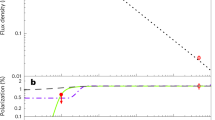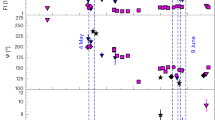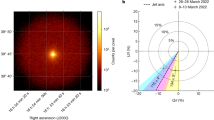Abstract
Newly formed black holes of stellar mass launch collimated outflows (jets) of ionized matter that approach the speed of light. These outflows power prompt, brief and intense flashes of γ-rays known as γ-ray bursts (GRBs), followed by longer-lived afterglow radiation that is detected across the electromagnetic spectrum. Measuring the polarization of the observed GRB radiation provides a direct probe of the magnetic fields in the collimated jets. Rapid-response polarimetric observations of newly discovered bursts have probed the initial afterglow phase1,2,3, and show that, minutes after the prompt emission has ended, the degree of linear polarization can be as high as 30 per cent—consistent with the idea that a stable, globally ordered magnetic field permeates the jet at large distances from the central source3. By contrast, optical4,5,6 and γ-ray7,8,9 observations during the prompt phase have led to discordant and often controversial10,11,12 results, and no definitive conclusions have been reached regarding the origin of the prompt radiation or the configuration of the magnetic field. Here we report the detection of substantial (8.3 ± 0.8 per cent from our most conservative simulation), variable linear polarization of a prompt optical flash that accompanied the extremely energetic and long-lived prompt γ-ray emission from GRB 160625B. Our measurements probe the structure of the magnetic field at an early stage of the jet, closer to its central black hole, and show that the prompt phase is produced via fast-cooling synchrotron radiation in a large-scale magnetic field that is advected from the black hole and distorted by dissipation processes within the jet.
This is a preview of subscription content, access via your institution
Access options
Access Nature and 54 other Nature Portfolio journals
Get Nature+, our best-value online-access subscription
$29.99 / 30 days
cancel any time
Subscribe to this journal
Receive 51 print issues and online access
$199.00 per year
only $3.90 per issue
Buy this article
- Purchase on SpringerLink
- Instant access to full article PDF
Prices may be subject to local taxes which are calculated during checkout



Similar content being viewed by others
References
Mundell, C. G. et al. Early optical polarization of a gamma-ray burst afterglow. Science 315, 1822–1824 (2007)
Steele, I. A., Mundell, C. G., Smith, R. J., Kobayashi, S. & Guidorzi, C. Ten per cent polarized optical emission from GRB090102. Nature 462, 767–769 (2009)
Mundell, C. G. et al. Highly polarized light from stable ordered magnetic fields in GRB 120308A. Nature 504, 119–121 (2013)
Kopacˇ, D. et al. Limits on optical polarization during the prompt phase of GRB 140430A. Astrophys. J. 813, 1 (2015)
Pruzhinskaya, M. V. et al. Optical polarization observations with the MASTER robotic net. New Astron. 29, 65–74 (2014)
Gorbovskoy, E. S. et al. Early polarization observations of the optical emission of gamma-ray bursts: GRB 150301B and GRB 150413A. Mon. Not. R. Astron. Soc. 455, 3312–3318 (2016)
Coburn, W. & Boggs, S. E. Polarization of the prompt γ-ray emission from the γ-ray burst of 6 December 2002. Nature 423, 415–417 (2003)
Götz, D., Laurent, P., Lebrun, F., Daigne, F. & Bošnjak, Ž. Variable polarization measured in the prompt emission of GRB 041219A using IBIS on board INTEGRAL. Astrophys. J. 695, L208–L212 (2009)
Yonetoku, D. et al. Magnetic structures in gamma-ray burst jets probed by gamma-ray polarization. Astrophys. J. 758, L1 (2012)
Rutledge, R. E. & Fox, D. B. Re-analysis of polarization in the γ-ray flux of GRB 021206. Mon. Not. R. Astron. Soc. 350, 1288–1300 (2004)
McGlynn, S. et al. Polarization studies of the prompt gamma-ray emission from GRB 041219a using the spectrometer aboard INTEGRAL. Astron. Astrophys. 466, 895–904 (2007)
Kalemci, E., Boggs, S. E., Kouveliotou, C., Finger, M. & Baring, M. G. Search for polarization from the prompt gamma-ray emission of GRB 041219a with SPI on INTEGRAL. Astrophys. J. 169 (Supp.), 75–82 (2007)
Dirirsa, F., Racusin, J., McEnery, J. & Desiante, R. GRB 160625B: Fermi-LAT detection of a bright burst. GCN Circ. 19580, https://gcn.gsfc.nasa.gov/other/160625B.gcn3 (2016)
Lipunov, V. et al. Master robotic net. Adv. Astron. 2010, 349171 (2010)
Piran, T. Gamma-ray bursts and the fireball model. Phys. Rep. 314, 575–667 (1999)
Kumar, P. & Zhang, B. The physics of gamma-ray bursts relativistic jets. Phys. Rep. 561, 1–109 (2015)
Kobayashi, S. Light curves of gamma-ray burst optical flashes. Astrophys. J. 545, 807–812 (2000)
Sari, R. & Mészáros, P. Impulsive and varying injection in gamma-ray burst afterglows. Astrophys. J. 535, L33–L37 (2000)
Zhang, B.-B. et al. Transition from fireball to Poynting-flux-dominated outflow in three-episode GRB 160625B. Preprint at https://arxiv.org/abs/1612.03089 (2016)
Gruzinov, A. & Waxman, E. Gamma-ray burst afterglow: polarization and analytic light curves. Astrophys. J. 511, 852–861 (1999)
Granot, J. & Königl, A. Linear polarization in gamma-ray bursts: the case for an ordered magnetic field. Astrophys. J. 594, L83–L87 (2003)
Rybicki, G. B . & Lightman, A. P. Radiative Processes in Astrophysics (Wiley-Interscience, 1979)
Inoue, T., Asano, K. & Ioka, K. Three-dimensional simulations of magnetohydrodynamic turbulence behind relativistic shock waves and their implications for gamma-ray bursts. Astrophys. J. 734, 77 (2011)
Lyutikov, M., Pariev, V. I. & Blandford, R. D. Polarization of prompt gamma-ray burst emission: evidence for electromagnetically dominated outflow. Astrophys. J. 597, 998–1009 (2003)
Zhang, B. & Yan, H. The internal-collision-induced magnetic reconnection and turbulence (ICMART) model of gamma-ray bursts. Astrophys. J. 726, 90 (2011)
Deng, W., Zhang, H., Zhang, B. & Li, H. Collision-induced magnetic reconnection and a unified interpretation of polarization properties of GRBs and blazars. Astrophys. J. 821, L12 (2016)
Bromberg, O. & Tchekhovskoy, A. Relativistic MHD simulations of core-collapse GRB jets: 3D instabilities and magnetic dissipation. Mon. Not. R. Astron. Soc. 456, 1739–1760 (2016)
Sironi, L. & Spitkovsky, A. Particle acceleration in relativistic magnetized collision-less electron-ion shocks. Astrophys. J. 726, 75 (2011)
Giannios, D. UHECRs from magnetic reconnection in relativistic jets. Mon. Not. R. Astron. Soc. 408, L46–L50 (2010)
Breeveld, A. A. et al. An updated ultraviolet calibration for the Swift/UVOT. Am. Inst. Phys. Conf. Ser. 1358, 373–376 (2011)
Bertin, E. & Arnouts, S. SExtractor: software for source extraction. Astron. Astrophys. 117 (Supp.), 393–404 (1996)
Chambers, K. C. et al. The Pan-STARRS1 surveys. Preprint available at https://arxiv.org/abs/1612.05560 (2016)
Skrutskie, M. F. et al. The Two Micron All Sky Survey (2MASS). Astron. J. 131, 1163–1183 (2006)
Sault, R. J., Teuben, P. J. & Wright, M. C. H. A retrospective view of MIRIAD. Astron. Data Analysis Software Systems IV 77, 433–436 (1995)
Uhm, Z. L. & Zhang, B. Fast-cooling synchrotron radiation in a decaying magnetic field and γ-ray burst emission mechanism. Nat. Phys. 10, 351–356 (2014)
Arnaud, K. A. XSPEC: the first ten years. Astron. Data Analysis Software Systems V 101, 17–20 (1996)
Band, D. et al. BATSE observations of gamma-ray burst spectra. I—spectral diversity. Astrophys. J. 413, 281–292 (1993)
Vestrand, W. T. et al. A link between prompt optical and prompt γ-ray emission in γ-ray bursts. Nature 435, 178–180 (2005)
Shen, R.-F. & Zhang, B. Prompt optical emission and synchrotron self-absorption constraints on emission site of GRBs. Mon. Not. R. Astron. Soc. 398, 1936–1950 (2009)
Gendre, B. et al. GRB 110205A: anatomy of a long gamma-ray burst. Astrophys. J. 748, 59 (2012)
Klotz, A., Boër, M., Atteia, J. L. & Gendre, B. Early optical observations of gamma-ray bursts by the TAROT telescopes: period 2001–2008. Astron. J. 137, 4100–4108 (2009)
Kumar, P. & Panaitescu, A. What did we learn from gamma-ray burst 080319B? Mon. Not. R. Astron. Soc. 391, L19–L23 (2008)
Yu, Y. W., Wang, X. Y. & Dai, Z. G. Optical and γ-ray emissions from internal forward-reverse shocks: application to GRB 080319B? Astrophys. J. 692, 1662–1668 (2009)
Giannios, D. Prompt GRB emission from gradual energy dissipation. Astron. Astrophys. 480, 305–312 (2008)
Wei, D. M. The GRB early optical flashes from internal shocks: application to GRB990123, GRB041219a and GRB060111b. Mon. Not. R. Astron. Soc. 374, 525–529 (2007)
Li, Z. & Waxman, E. Prompt optical emission from residual collisions in gamma-ray burst outflows. Astrophys. J. 674, L65–L68 (2008)
Fan, Y. Z., Zhang, B. & Wei, D. M. Early optical-infrared emission from GRB 041219a: neutron-rich internal shocks and a mildly magnetized external reverse shock. Astrophys. J. 628, L25–L28 (2005)
Serkowski, K., Matheson, D. S. & Ford, V. L. Wavelength dependence of interstellar polarisation and ratio of total to selective extinction. Astrophys. J. 196, 261 (1975)
Granot, J. & Sari, R. The shape of spectral breaks in gamma-ray burst afterglows. Astrophys. J. 568, 820–829 (2002)
Cenko, S. B. et al. Afterglow observations of Fermi large area telescope gamma-ray bursts and the emerging class of hyper-energetic events. Astrophys. J. 732, 29 (2011)
Ackermann, M. et al. Multiwavelength observations of GRB 110731A: GeV emission from onset to afterglow. Astrophys. J. 763, 71 (2013)
Zhang, B., Kobayashi, S. & Mészáros, P. Gamma-ray burst early optical afterglows: implications for the initial Lorentz factor and the central engine. Astrophys. J. 595, 950–954 (2003)
Zhang, B. & Kobayashi, S. Gamma-ray burst early afterglows: reverse shock emission from an arbitrarily magnetized ejecta. Astrophys. J. 628, 315–334 (2005)
Acknowledgements
E.T. thanks L. Piro and K. Murase for comments. We thank the RATIR (Reionization And Transients InfraRed) project team and the staff of the Observatorio Astronómico Nacional on Sierra San Pedro Mártir, and acknowledge the contribution of L. Georgiev and J.S. Bloom to the development of this observatory. RATIR is a collaboration between the University of California, the Universidad Nacional Autonóma de México, the NASA Goddard Space Flight Center and Arizona State University, and benefits from the loan of an H2RG detector and hardware and software support from Teledyne Scientific and Imaging. RATIR, the automation of the Harold L. Johnson Telescope of the Observatorio Astronómico Nacional on Sierra San Pedro Mártir, and the operation of both are funded through NASA grants NNX09AH71G, NNX09AT02G, NNX10AI27G and NNX12AE66G, CONACyT grants INFR-2009-01-122785 and CB-2008-101958, UNAM PAPIIT grant IN113810, and UC MEXUS-CONACyT grant CN 09-283. The MASTER project is supported in part by the Development Program of Lomonosov Moscow State University, Moscow Union OPTICA, Russian Science Foundation grant 16-12-00085. This work was supported in part by NASA Fermi grants NNH14ZDA001N and NNH15ZDA001N. This work made use of data supplied by the UK Swift Science Data Centre at the University of Leicester, funded by the UK Space Agency.
Author information
Authors and Affiliations
Contributions
E.T., C.G.M. and S.K. composed the text on the basis of inputs from all authors. MASTER data were provided, reduced and analysed by V.M.L., E.S.G. and N.V.T. RATIR observations were obtained, reduced and analysed by N.R.B., E.T., A.M.W., A.K., W.H.L. and V.T. F.E.M. processed and analysed the Swift/Ultraviolet–Optical Telescope (UVOT) data. E.T., R.R. and M.H.W. obtained, processed and analysed the Australian Telescope Compact Array (ATCA) observations (E.T. was the principal investigator). Jansky Very Large Array (VLA) observations were obtained, processed and analysed by S.B.C., A.F. and A.H. (with S.B.C. being the principal investigator). All authors helped to obtain parts of the presented dataset, to discuss the results or to comment on the manuscript.
Corresponding author
Ethics declarations
Competing interests
The authors declare no competing financial interests.
Additional information
Reviewer Information Nature thanks D. Giannios and the other anonymous reviewer(s) for their contribution to the peer review of this work.
Publisher's note: Springer Nature remains neutral with regard to jurisdictional claims in published maps and institutional affiliations.
Extended data figures and tables
Extended Data Figure 1 Multiwavelength light curves for GRB 160625B and its afterglow.
Different emission components shape the temporal evolution of GRB 160625B. On timescales of seconds to minutes after the explosion, we observe bright prompt (solid lines) and reverse-shock (dotted lines) components. On timescales of hours to weeks after the burst, emission from the forward shock (dashed lines) becomes the dominant component from X-rays down to radio energies. After about 14 days, the afterglow emission falls off at all wavelengths. This phenomenon, known as jet-break, is caused by the beamed geometry of the outflow. Error bars denote 1σ limits; upper limits are 3σ. Times are given with reference to the LAT trigger time T0. FS, forward shock; RS, reverse shock; a subscript ‘v’ refers to frequency; u, V, r, i, z, y, J and H denote specific optical filters.
Extended Data Figure 2 Results of Monte Carlo simulations.
For each of the four polarization epochs, we simulated and examined a large number of data sets with similar photometric properties and no intrinsic afterglow polarization. a, Results of 105 simulations for the first epoch (95–115 seconds). b, As for a, but for the second epoch (144–174 seconds). c, Results of 106 simulations for the third epoch (186–226 seconds). d, As for c, but for the fourth epoch (300–360 seconds). The observed values are shown by vertical arrows. The probability of obtaining by chance a polarization measurement as high as the observed value is also reported. Πmin, minimum polarization value.
Extended Data Figure 3 Comparison of the early γ-ray and optical emission measured for GRB 160625B.
a, γ-ray light curves in the soft (50–300 keV) energy band. b, γ-ray light curves in the hard (5–40 MeV) energy band. Optical data (blue circles) have been arbitrarily rescaled. The squared points (in the background) show the γ-ray light curves re-binned by adopting the same time intervals as for the optical observations. Times are given with reference to the LAT trigger time T0. The horizontal bars show the time interval (5 s) over which the observation was taken.
Extended Data Figure 4 Afterglow spectral energy distributions of GRB 160625B.
The afterglow evolution can be described by the combination of forward-shock (dashed lines) and reverse-shock (dotted lines) emission. The best-fit model is shown with solid lines. The peak flux of the forward-shock component is about 0.4 mJy, much lower than the optical flux measured at T < T0 + 350 seconds. This shows that the forward-shock emission is negligible during the prompt phase. Error bars denote 1σ limits; upper limits are 3σ.
Rights and permissions
About this article
Cite this article
Troja, E., Lipunov, V., Mundell, C. et al. Significant and variable linear polarization during the prompt optical flash of GRB 160625B. Nature 547, 425–427 (2017). https://doi.org/10.1038/nature23289
Received:
Accepted:
Published:
Issue Date:
DOI: https://doi.org/10.1038/nature23289
This article is cited by
-
Science with the Daksha high energy transients mission
Experimental Astronomy (2024)
-
Prompt-to-afterglow transition of optical emission in a long gamma-ray burst consistent with a fireball
Nature Astronomy (2023)
-
Exceptionally bright optical emission from a rare and distant gamma-ray burst
Nature Astronomy (2023)
-
Science with the 2.5-meter Wide Field Survey Telescope (WFST)
Science China Physics, Mechanics & Astronomy (2023)
-
A deep study of the high–energy transient sky
Experimental Astronomy (2021)



